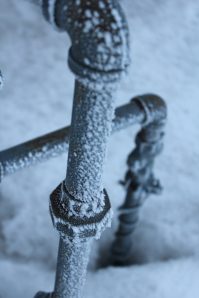As a cabin owner, you can probably imagine the frustration of putting your time, energy, and money into your cabin only for the pipes to freeze and burst. Unfortunately, this is a concern that all homeowners have in subzero temperatures. Thankfully, when thinking about how to keep pipes from freezing, there are several preventative measures that you can take! Keep reading to find out what they are.
How to Keep Pipes from Freezing in Your Cabin
 Why Pipe Freezing is Damaging
Why Pipe Freezing is Damaging
When water freezes, it expands. This puts high pressure on whatever is containing the water, including pipes. No matter whether the pipes are metal or plastic, expanding water can cause them to burst. Pipes that are most likely to freeze are:
- Pipes that are exposed to extreme cold, like outdoor pipes and sprinkler lines
- Indoor water supply pipes in unheated areas like basements or garages
- Pipes that run against walls that have little insulation
How to Keep Pipes from Freezing
Let the Water Drip
A trickle of water out of the faucet may be all it takes to prevent the pipes in your cabin from freezing. Turn on one or more of your faucets so that there is a tiny trickle of water. This prevents pressure from building up inside the pipes. Additionally, the constant flow of water, although small, greatly decreases the odds of pipes freezing.
Seal Cracks and Holes
Check your cabin for leaks that let the cold air inside, especially near where pipes are located. If you find any, use caulk or insulation to keep the cold air out. If you’re able to, seal holes on both the interior and exterior sides of the wall.
Open Cabinet Doors
Many pipes are located in cabinets, so it’s a good idea to keep these doors open in frigid temperatures. This allows the warmer air in your cabin to circulate into the cabinets and around the plumbing. It’s also smart to keep other interior doors open as well, like bedroom and bathroom doors. The key is to keep the warm air circulating throughout the inside of your cabin as much as possible.
Apply Heat Cable
Electric heat cable is an effective form of protection for your pipes during cold spells. It supplies heat directly to the pipe to keep it warm. Many types of heat tape turn on and off by themselves when the temperature drops. That way, the cable won’t waste energy when it isn’t necessary. Keep in mind that heating tape is rather pricey, so if you need to protect a lot of pipes for long periods of time, it may not be your best option.
Add Insulation
If your cabin is in a naturally cold climate, it may be a good idea to add some insulation to areas that don’t get much heat, like basements, garages, crawl spaces, etc. This will help to maintain a higher temperature in these areas. However, insulation can become expensive if your walls or floors have to be opened in order to insulates the pipes.
Need some more information on how to keep pipes from freezing in the cabin? Contact us!
